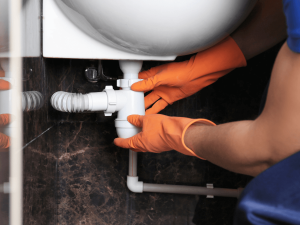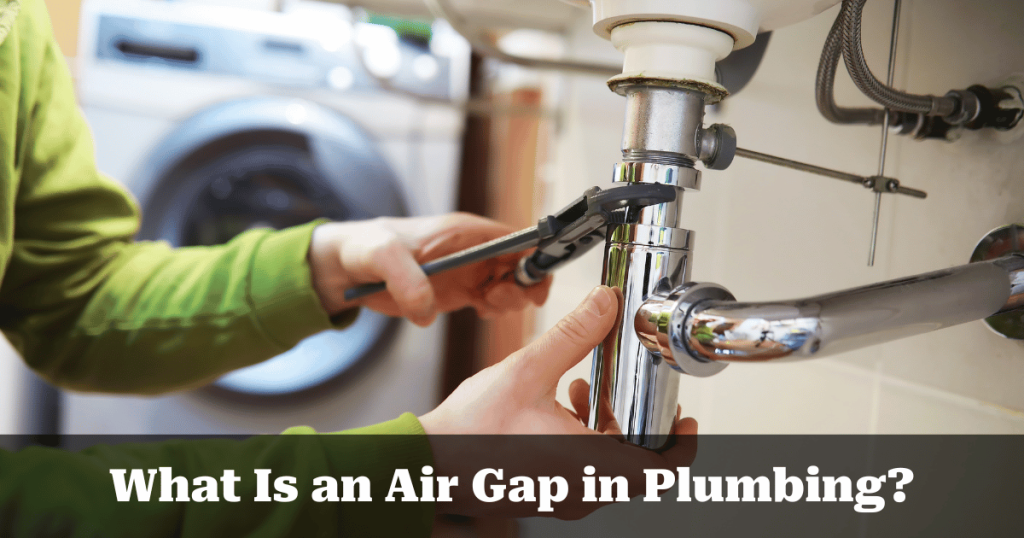In the world of plumbing, an often overlooked but vital component is the air gap. This simple yet effective mechanism is key to keeping your drinking water safe from contamination. An air gap works by creating a physical space between the end of a water supply line and any potential source of contamination. Think of it as a protective barrier that ensures your water doesn’t flow backward and mix with dirty water due to changes in pressure or a vacuum in the system. It’s like having a little guardian that keeps the bad stuff away from your potable water, ensuring that what comes out of your tap is clean and safe to drink.
You’ll find air gaps in various places around your home, serving as silent protectors of your water supply. They are commonly located in areas where the water supply could potentially be compromised, such as kitchen sinks, dishwashers, and even some types of outdoor faucets. Plumbers install these gaps to prevent backflow, a condition where dirty water could reverse direction and contaminate the clean water line. Without an air gap, the risk of pollutants seeping back into your drinking water is significantly increased. By understanding the role and importance of air gaps in your plumbing system, you’re taking a crucial step toward maintaining a healthy and safe home environment.
Understanding Air Gaps in Plumbing
An air gap in plumbing is like a safety gap that keeps our drinking water safe from dirt and germs. Imagine a space, at least the length of two stacked coins, between the end of a water faucet and the top edge of a sink. This space stops dirty water from moving back into the pipes that bring fresh water to our homes. Dirty water can sometimes try to move backward when there’s a sudden drop in water pressure or when a vacuum is created in the pipes. This could happen, for example, if a hose connected to a faucet is left in a pool of dirty water and the pressure in the water supply drops. The air gap stops this backward movement, ensuring that the water we drink and cook with stays clean.
Plumbers install air gaps because they are a simple and effective way to protect our water supply from contamination. Without an air gap, contaminated water could easily mix with the potable (safe to drink) water if there’s a backflow situation. Backflow means the water is going in the opposite direction from normal, which could introduce harmful substances into our clean water. Think of an air gap as a guard that keeps our water safe by maintaining a clear, physical distance between clean water and potential sources of pollution. This gap is crucial in preventing any contaminated water from making its way back into our taps, ensuring that the water remains safe and clean for use.
The Vital Role of Air Gaps
Air gaps are like invisible superheroes in the plumbing world, ensuring that the water you drink is clean and safe. Imagine a small space, or “gap,” that plumbers create to keep your fresh drinking water away from any dirty water that might be lurking around. This gap is essential because it stops bad water from sneaking back into the good water you use every day. Let’s break down why air gaps are so crucial.
- Stopping Backflow: Backflow is a real thing in plumbing that we need to guard against. It happens when water goes in the reverse direction from its intended path, potentially bringing contaminants back into your clean water supply. Air gaps act like a protective barrier, making sure water flows only one way—away from any danger. By maintaining a physical distance between the clean water you drink and sources that could pollute it, air gaps prevent this backflow effectively.
- Keeping Water Pure: The main job of an air gap is to keep your drinking water clean. Think of it as a guardian that stops harmful contaminants from getting into the water you drink, cook with, or bathe in. This tiny space of air ensures that your water supply remains free from pollutants, safeguarding your health and well-being. Without air gaps, the risk of contamination increases, which could lead to water quality issues that nobody wants.
- Following the Compliance: Plumbers don’t just install air gaps because they think it’s a good idea; they do it because it’s often required by plumbing codes. These codes are like the rulebooks that ensure public health is protected. By following these rules and installing air gaps where needed, plumbers help prevent contamination of the water supply on a larger scale. This means that when you see an air gap in your plumbing system, it’s there to meet specific standards and keep everyone safe.
In the world of plumbing, air gaps play a critical role in keeping our water clean, safe, and flowing in the right direction. They prevent backflow, ensure water quality, and help plumbers comply with important health and safety codes. So, next time you turn on the tap, remember the invisible hero—the air gap—working silently to protect your water supply.
Common Applications of Air Gaps in Your Home
Air gaps in plumbing serve as a simple yet crucial defense mechanism, ensuring our clean water supply remains uncontaminated by potentially hazardous water.
- In Sinks and Faucets: Have you ever noticed the space between the bottom of your kitchen or bathroom faucet and the top of the sink? This isn’t just a design choice; it’s a practical feature known as an air gap. This gap plays a vital role in keeping your water clean by preventing a situation where dirty water from a full sink might flow back into the clean water supply. Imagine your sink overflows with water that’s been used for cleaning dishes or washing hands. Thanks to the air gap, even in such scenarios, the dirty water can’t travel back up the faucet and contaminate the clean water pipeline. This simple air space acts as a barrier, ensuring that the water coming out of your faucet remains clean and safe to use.
- Dishwashers: Dishwashers are another household appliance where air gaps prove to be indispensable. Usually found on the countertop or at the edge of the sink, the dishwasher air gap is a small, often overlooked device that serves a mighty purpose. It prevents dirty water and food particles, which could have been pulled back by a vacuum or backflow in the plumbing system, from re-entering the clean water supply line of the dishwasher. This is particularly important for dishwashers because they deal with a mix of food debris, detergent, and water that, if allowed back into the clean water supply, could pose health risks. This air gap ensures that there is no direct connection between the dishwasher’s dirty water hose and the clean water supply. If a sudden drop in water pressure occurs or a vacuum is created in the water supply line, the air gap prevents contaminated water from being sucked back into the clean water system. By maintaining this separation, plumbers ensure that the potable water remains safe and free from contaminants, safeguarding our health.
Air gaps might seem like a small and perhaps insignificant part of plumbing to the untrained eye, but their role is critical in maintaining the quality of our water supply. These gaps ensure that the water we drink and use daily remains clean, safe, and free from backflow contamination, highlighting the ingenious simplicity of plumbing designs in safeguarding public health.
Installation and Maintenance: Keeping Air Gaps Functional
Installing and maintaining air gaps is relatively straightforward, but crucial for their effectiveness. Here are some key points to consider:
- Proper Installation: Ensure that air gaps are installed according to local codes and standards, typically by a professional plumber.
- Regular Checks: Inspect air gaps periodically for blockages or debris that might compromise their functionality.
- Immediate Action: If water spills out of an air gap, it’s a sign of a blockage or other issue that needs immediate attention.
Air gaps may be small and easy to overlook, but their role in maintaining a safe and healthy water supply is anything but insignificant. By preventing the backflow of contaminated water, they ensure that your home’s water remains clean and safe for everyday use. Whether you’re washing dishes, taking a shower, or simply getting a glass of water, the humble air gap works tirelessly behind the scenes to protect your water’s purity and your family’s health.
Remember, keeping an eye on these critical components and ensuring they are in good working order is a simple yet effective step toward maintaining a healthy home. If you have any concerns or questions about air gaps or other plumbing needs, consulting with a professional plumber can provide peace of mind and ensure that your plumbing system is functioning optimally.
When to Contact a Professional

At Trusted Plumbing & Heating, we’re not just about providing exceptional plumbing services; we’re about creating lasting relationships with our clients, ensuring you always have a trusted partner for all your plumbing and heating needs. Your comfort, safety, and satisfaction are our top priorities, and we’re here to exceed your expectations at every turn. Call us at (206) 472-7979 or contact us to get a quote.
At Trusted Plumbing & Heating, we believe in transparency, innovation, and unwavering dedication to our customers. Let us show you why we’re the go-to choice for plumbing and heating services in Western Washington. Contact us today, and experience the Trusted Plumbing & Heating difference!


